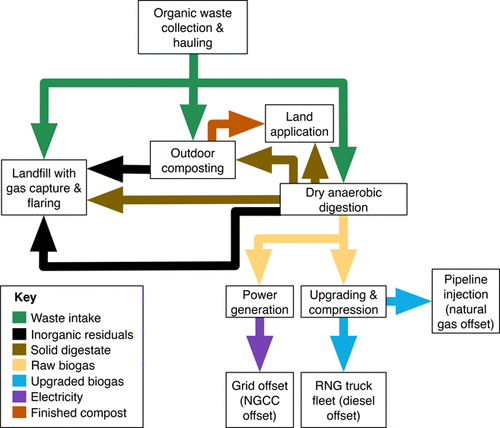当前位置:
X-MOL 学术
›
Environ. Sci. Technol.
›
论文详情
Our official English website, www.x-mol.net, welcomes your
feedback! (Note: you will need to create a separate account there.)
Life-Cycle Greenhouse Gas Emissions and Human Health Trade-Offs of Organic Waste Management Strategies.
Environmental Science & Technology ( IF 10.8 ) Pub Date : 2020-07-06 , DOI: 10.1021/acs.est.0c00364 Sarah L Nordahl 1, 2 , Jay P Devkota 1 , Jahon Amirebrahimi 1, 3 , Sarah Josephine Smith 1, 2 , Hanna M Breunig 1 , Chelsea V Preble 1, 2 , Andrew J Satchwell 1 , Ling Jin 1 , Nancy J Brown 1 , Thomas W Kirchstetter 1, 2 , Corinne D Scown 1, 4, 5
Environmental Science & Technology ( IF 10.8 ) Pub Date : 2020-07-06 , DOI: 10.1021/acs.est.0c00364 Sarah L Nordahl 1, 2 , Jay P Devkota 1 , Jahon Amirebrahimi 1, 3 , Sarah Josephine Smith 1, 2 , Hanna M Breunig 1 , Chelsea V Preble 1, 2 , Andrew J Satchwell 1 , Ling Jin 1 , Nancy J Brown 1 , Thomas W Kirchstetter 1, 2 , Corinne D Scown 1, 4, 5
Affiliation

|
Waste-to-energy systems can play an important role in diverting organic waste from landfills. However, real-world waste management can differ from idealized practices, and emissions driven by microbial communities and complex chemical processes are poorly understood. This study presents a comprehensive life-cycle assessment, using reported and measured data, of competing management alternatives for organic municipal solid waste including landfilling, composting, dry anaerobic digestion (AD) for the production of renewable natural gas (RNG), and dry AD with electricity generation. Landfilling is the most greenhouse gas (GHG)-intensive option, emitting nearly 400 kg CO2e per tonne of organic waste. Composting raw organics resulted in the lowest GHG emissions, at −41 kg CO2e per tonne of waste, while upgrading biogas to RNG after dry AD resulted in −36 to −2 kg CO2e per tonne. Monetizing the results based on social costs of carbon and other air pollutant emissions highlights the importance of ground-level NH3 emissions from composting nitrogen-rich organic waste or post-AD solids. However, better characterization of material-specific NH3 emissions from landfills and land-application of digestate is essential to fully understand the trade-offs between alternatives.
中文翻译:

生命周期温室气体排放与有机废物管理策略的人类健康权衡。
废物转化为能源的系统在从垃圾填埋场转移有机废物方面可以发挥重要作用。但是,现实世界中的废物管理可能不同于理想的做法,并且人们对由微生物群落和复杂化学过程驱动的排放知之甚少。本研究使用报告和测量的数据,对有机市政固体废物的竞争性管理替代方案(包括垃圾填埋,堆肥,生产可再生天然气(RNG)的干式厌氧消化(AD)和干式AD)的竞争性管理方案进行了全面的生命周期评估。发电。垃圾填埋场是温室气体(GHG)最密集的选项,每吨有机废物排放近400千克CO 2e。堆肥原料有机物导致最低的GHG排放,为−41 kg CO 2e每吨废料,同时在干法AD后将沼气升级为RNG会导致每吨−36至−2 kg CO 2e。根据碳和其他空气污染物排放的社会成本将结果货币化,凸显了堆肥富含氮的有机废物或AD后固体产生的地面NH 3排放的重要性。但是,更好地表征垃圾填埋场中特定材料的NH 3排放以及消化物在土地上的应用对于全面了解替代方案之间的权衡至关重要。
更新日期:2020-08-04
中文翻译:

生命周期温室气体排放与有机废物管理策略的人类健康权衡。
废物转化为能源的系统在从垃圾填埋场转移有机废物方面可以发挥重要作用。但是,现实世界中的废物管理可能不同于理想的做法,并且人们对由微生物群落和复杂化学过程驱动的排放知之甚少。本研究使用报告和测量的数据,对有机市政固体废物的竞争性管理替代方案(包括垃圾填埋,堆肥,生产可再生天然气(RNG)的干式厌氧消化(AD)和干式AD)的竞争性管理方案进行了全面的生命周期评估。发电。垃圾填埋场是温室气体(GHG)最密集的选项,每吨有机废物排放近400千克CO 2e。堆肥原料有机物导致最低的GHG排放,为−41 kg CO 2e每吨废料,同时在干法AD后将沼气升级为RNG会导致每吨−36至−2 kg CO 2e。根据碳和其他空气污染物排放的社会成本将结果货币化,凸显了堆肥富含氮的有机废物或AD后固体产生的地面NH 3排放的重要性。但是,更好地表征垃圾填埋场中特定材料的NH 3排放以及消化物在土地上的应用对于全面了解替代方案之间的权衡至关重要。











































 京公网安备 11010802027423号
京公网安备 11010802027423号